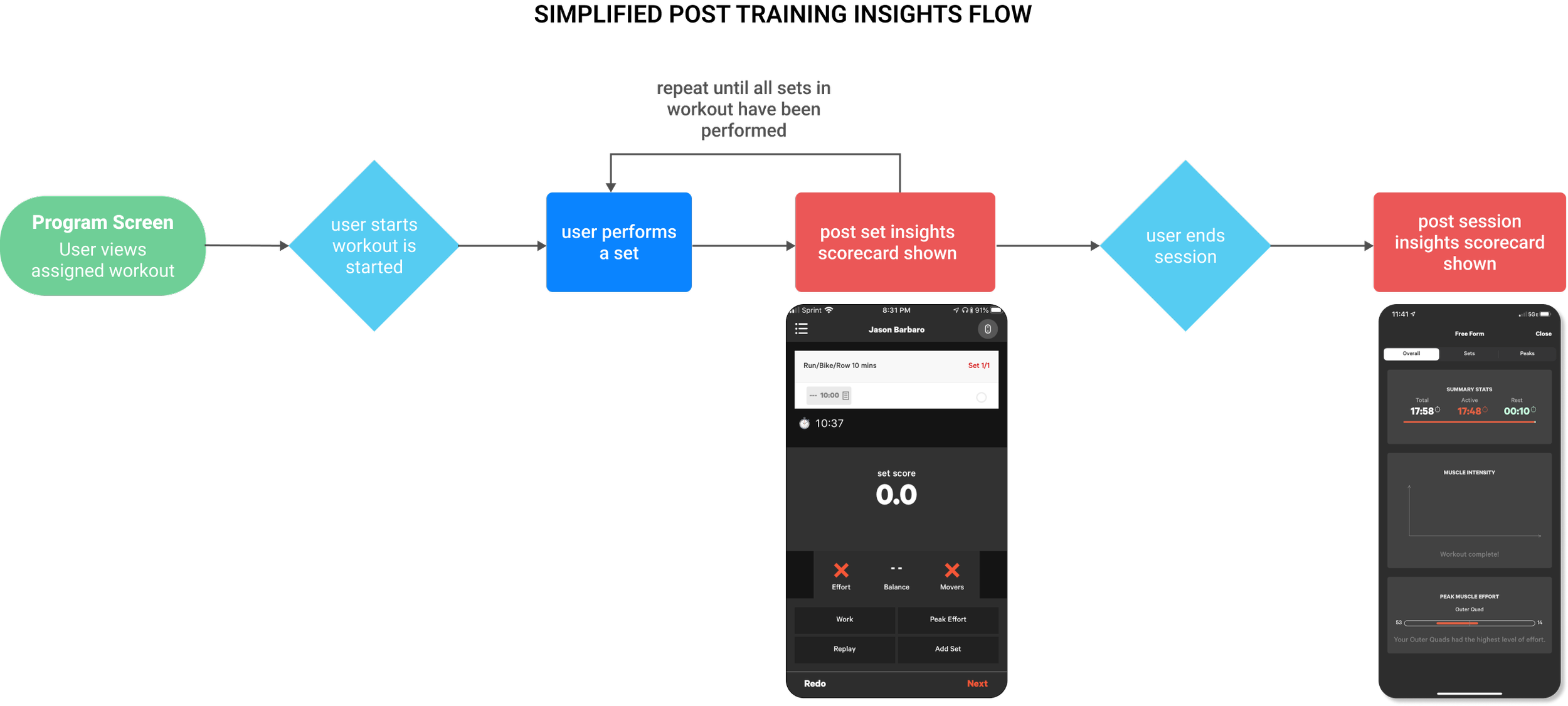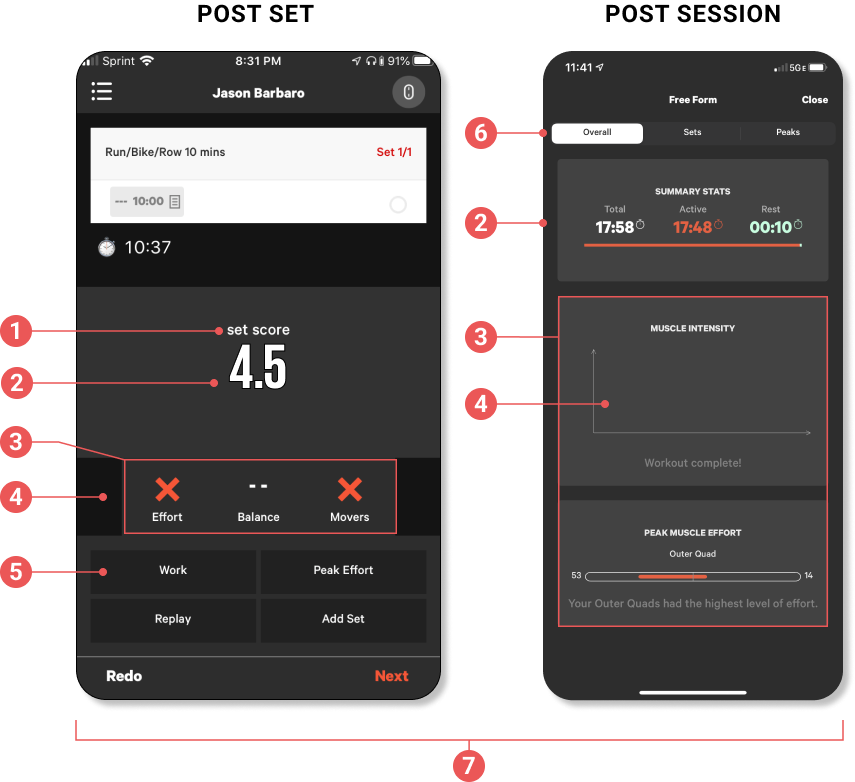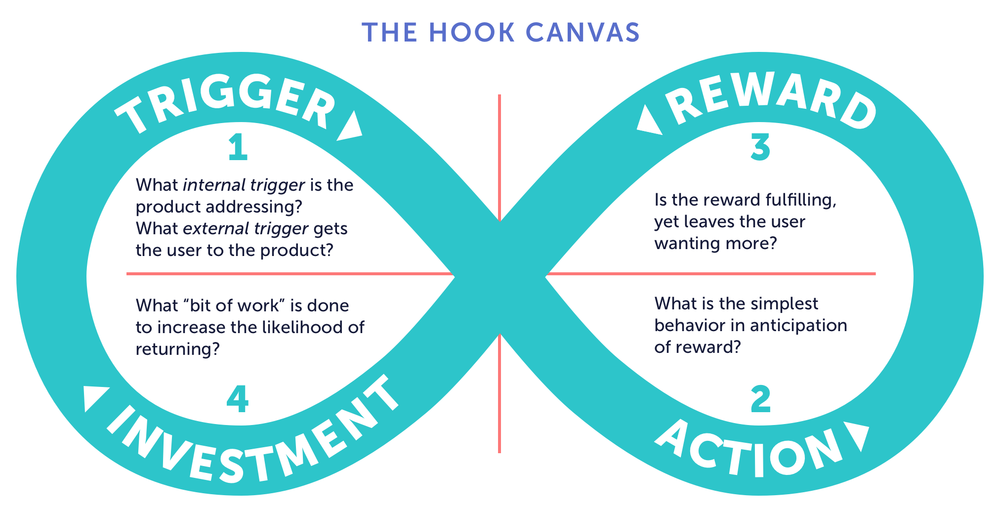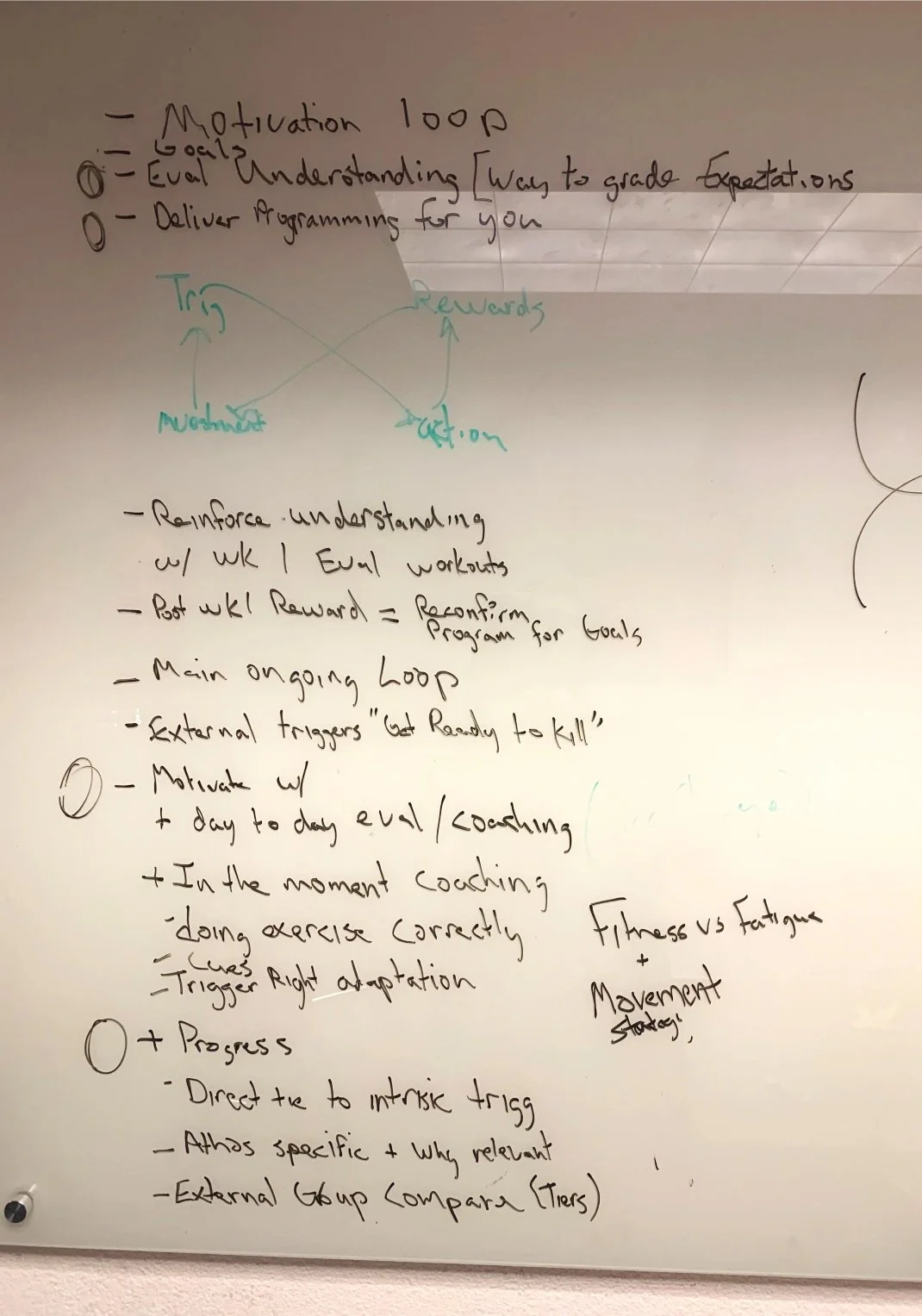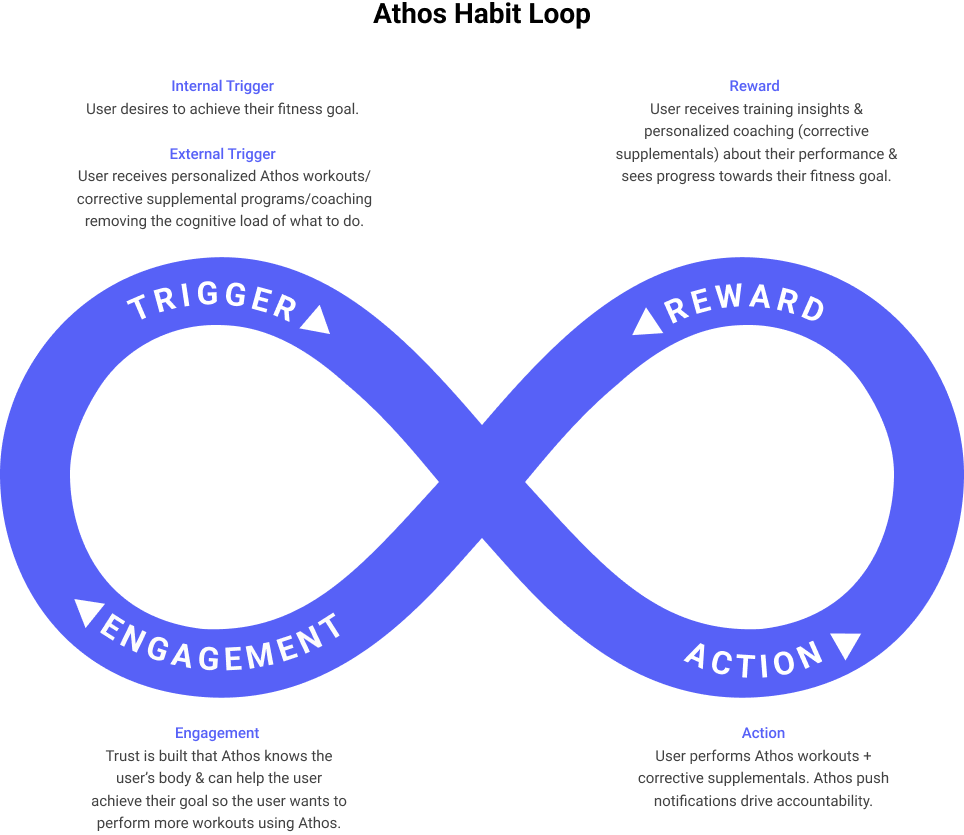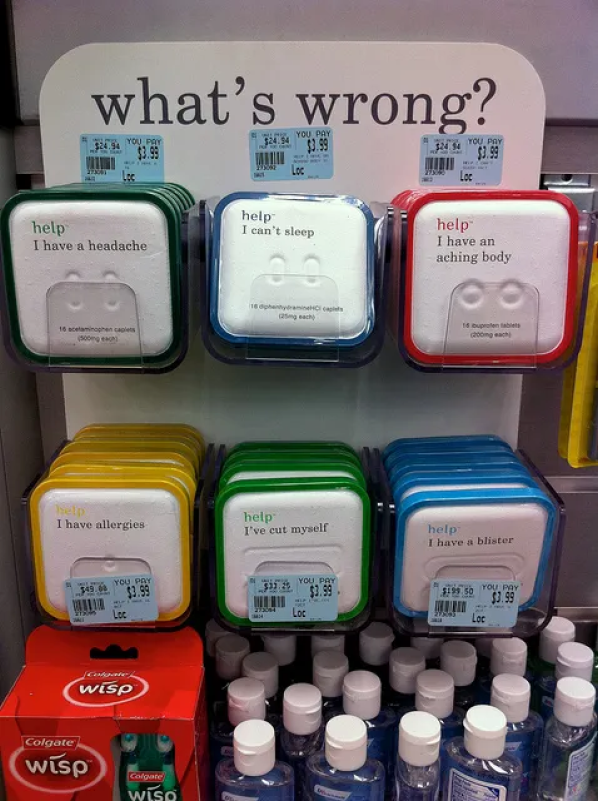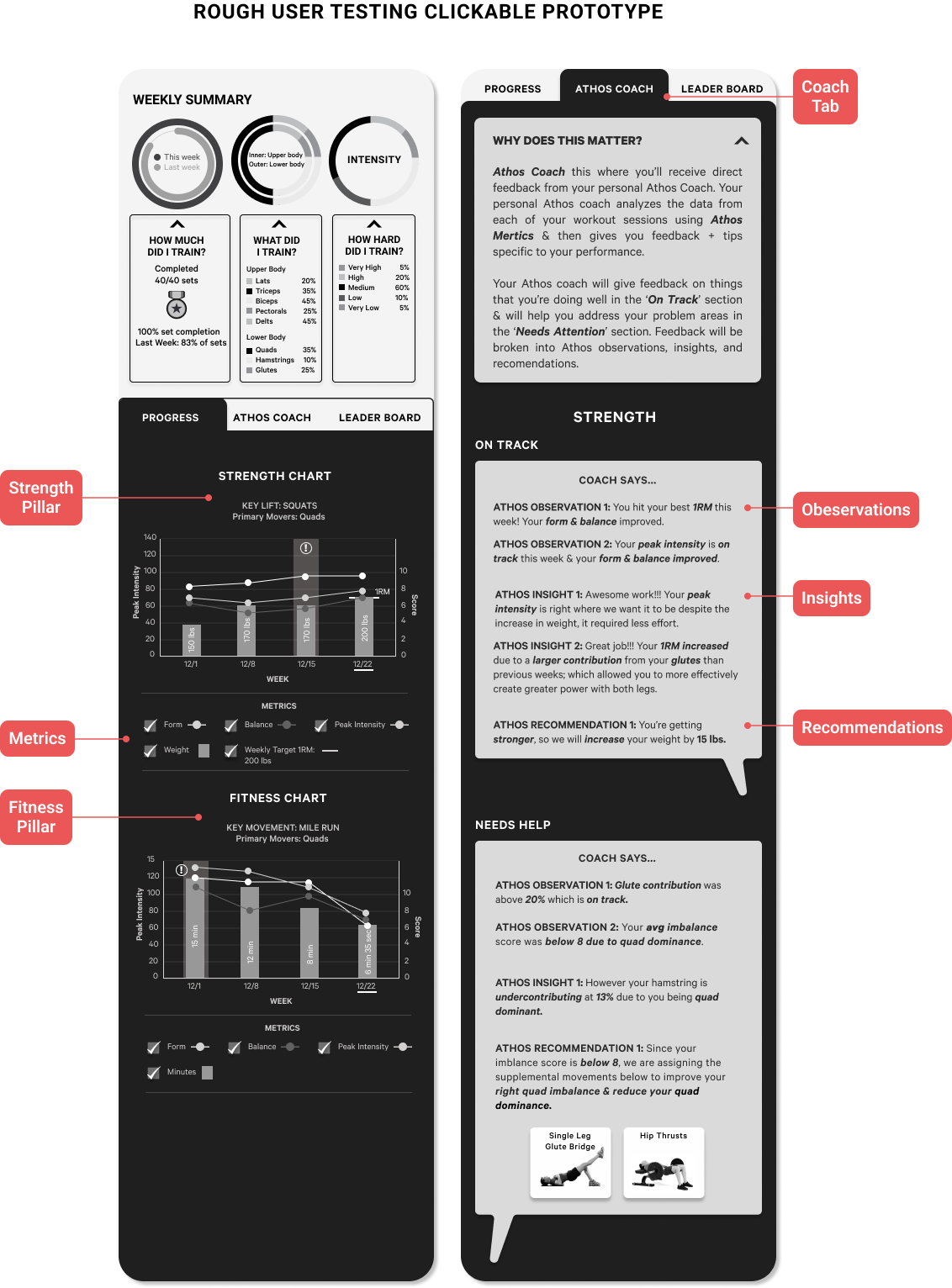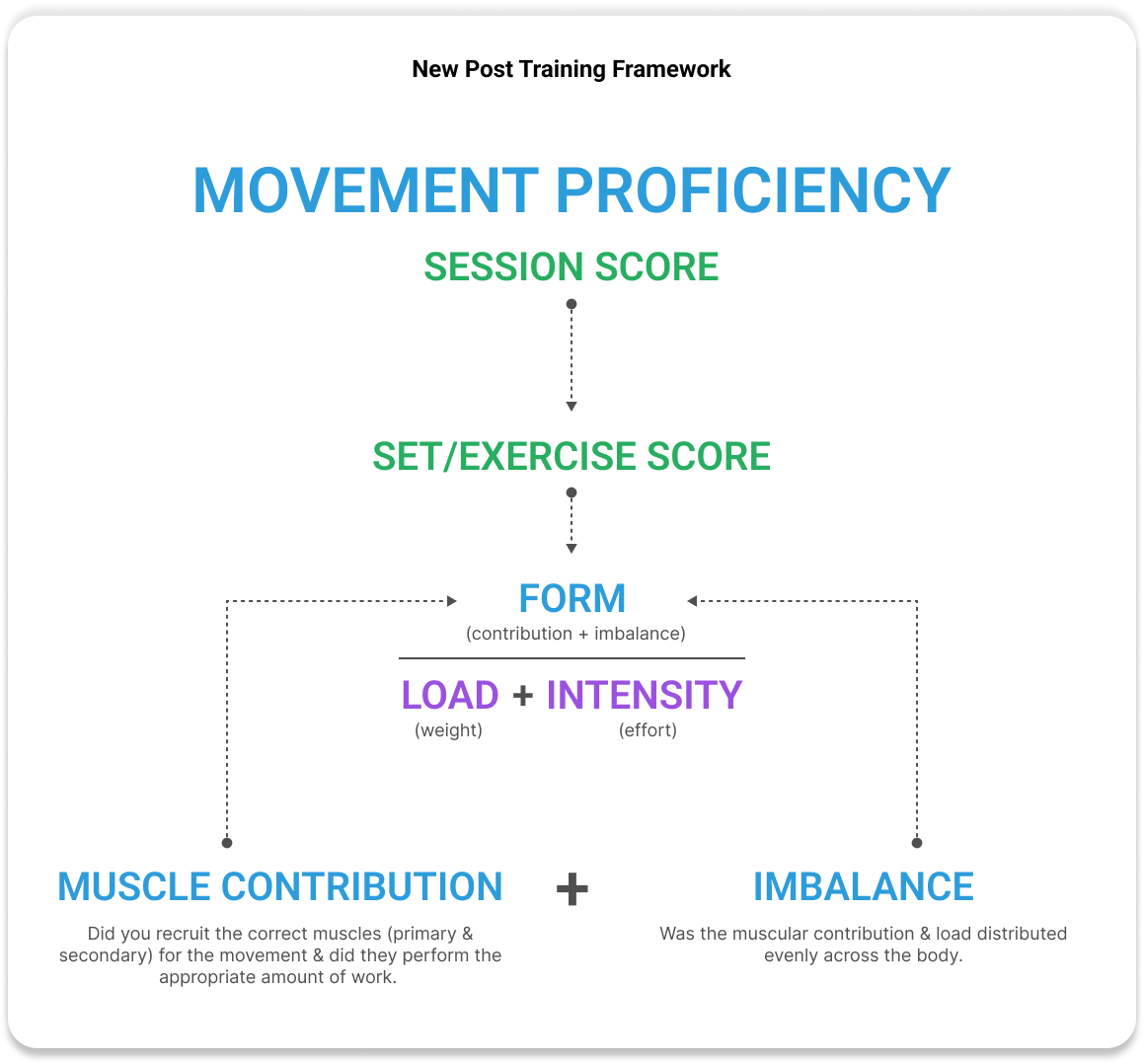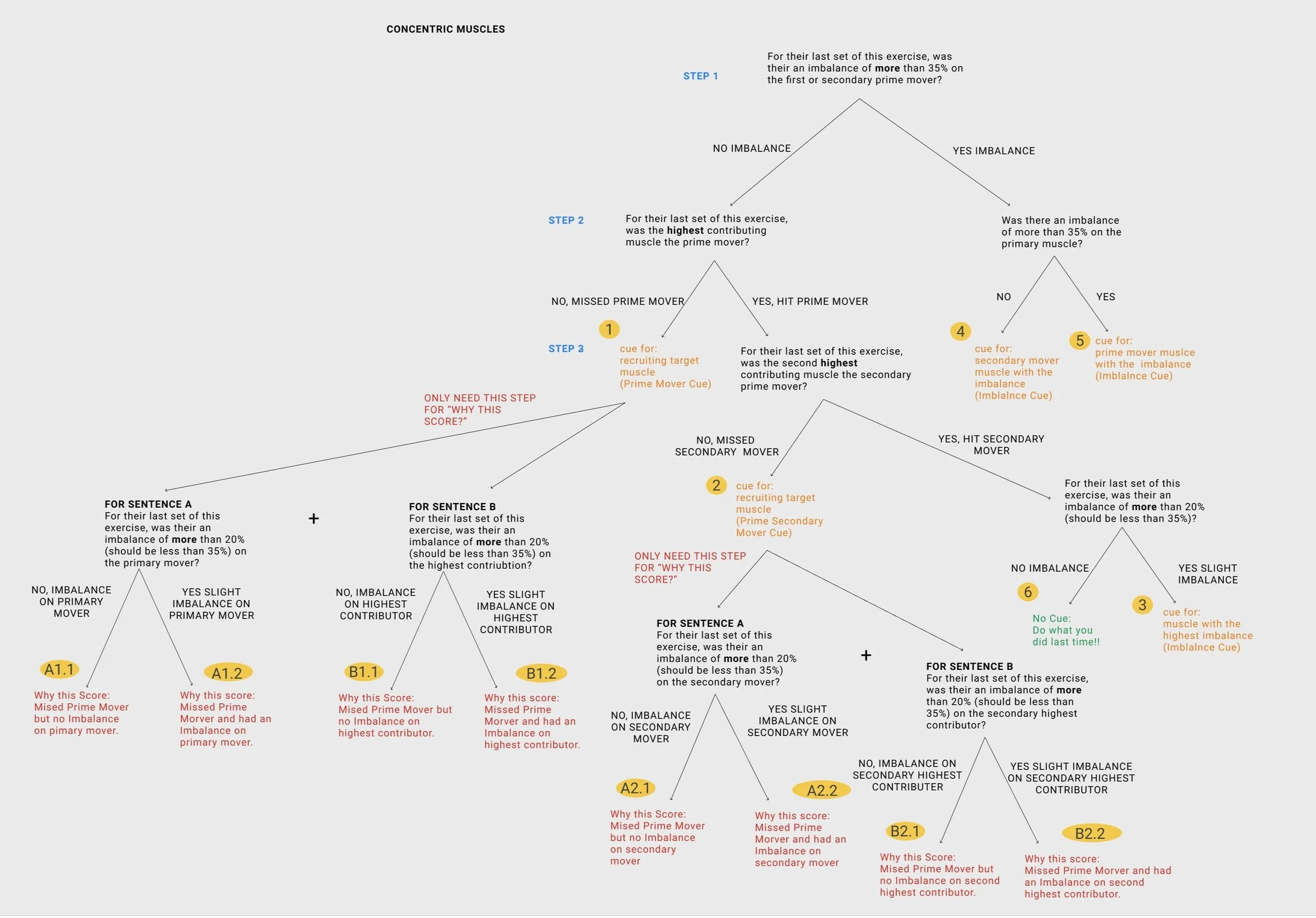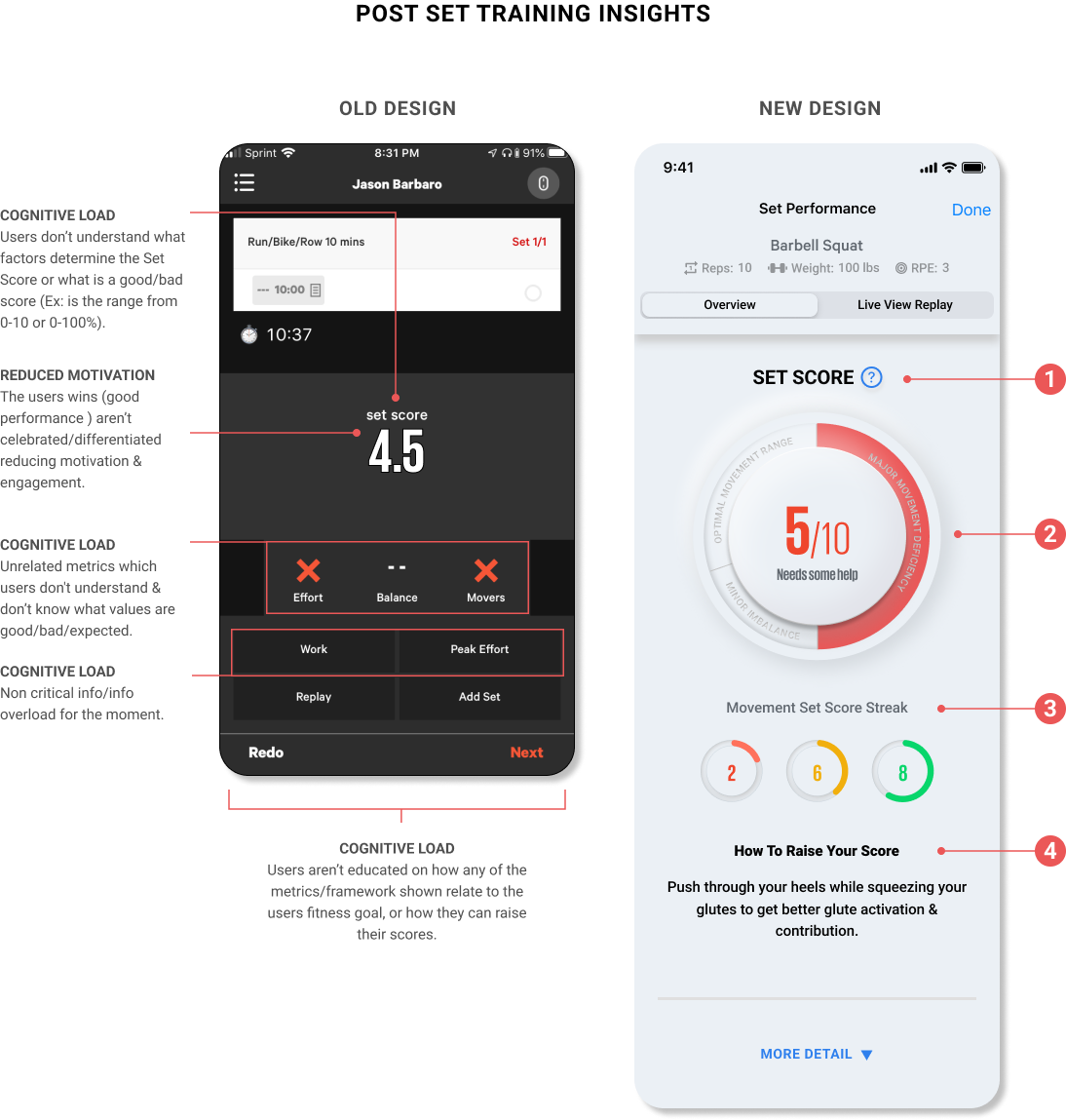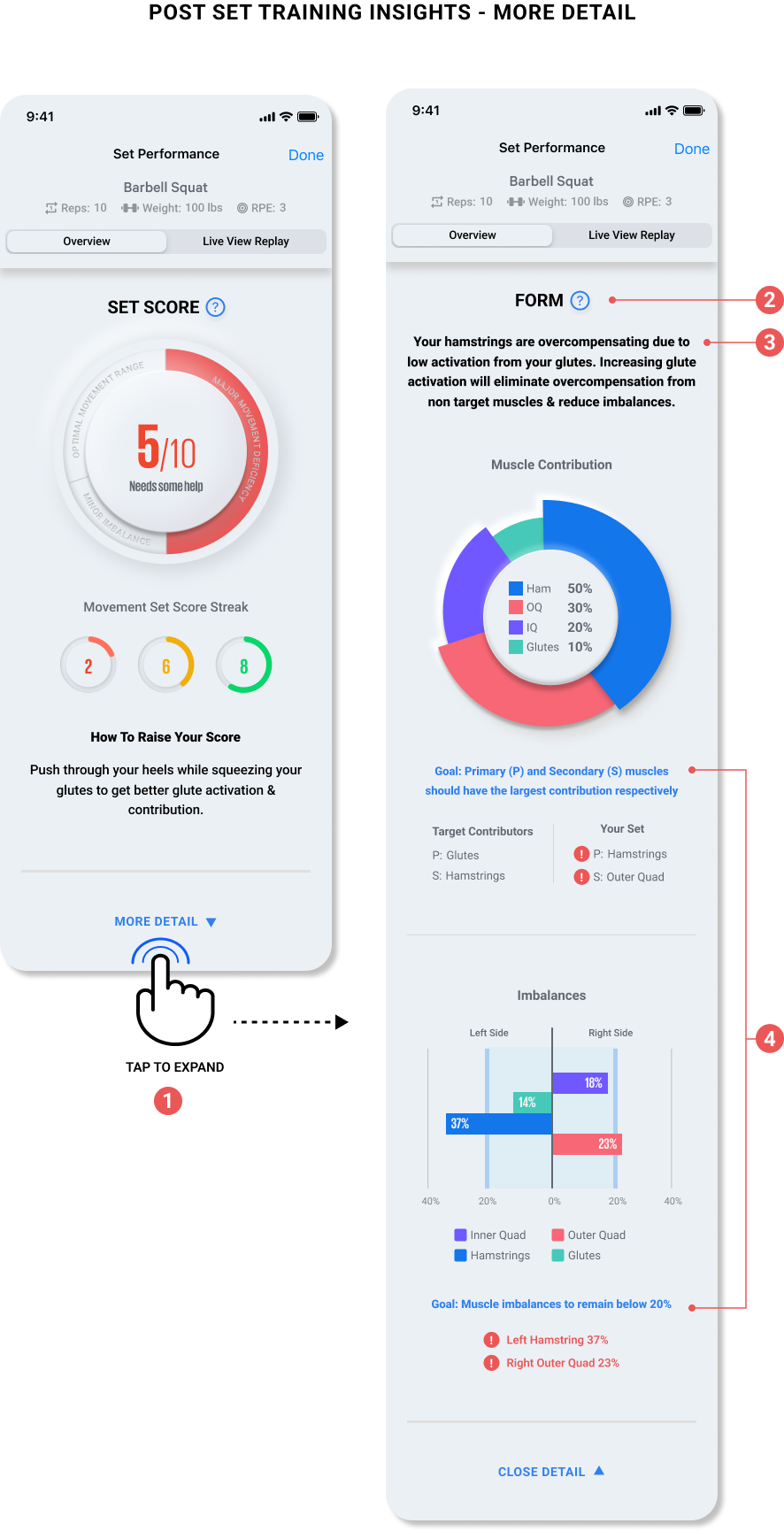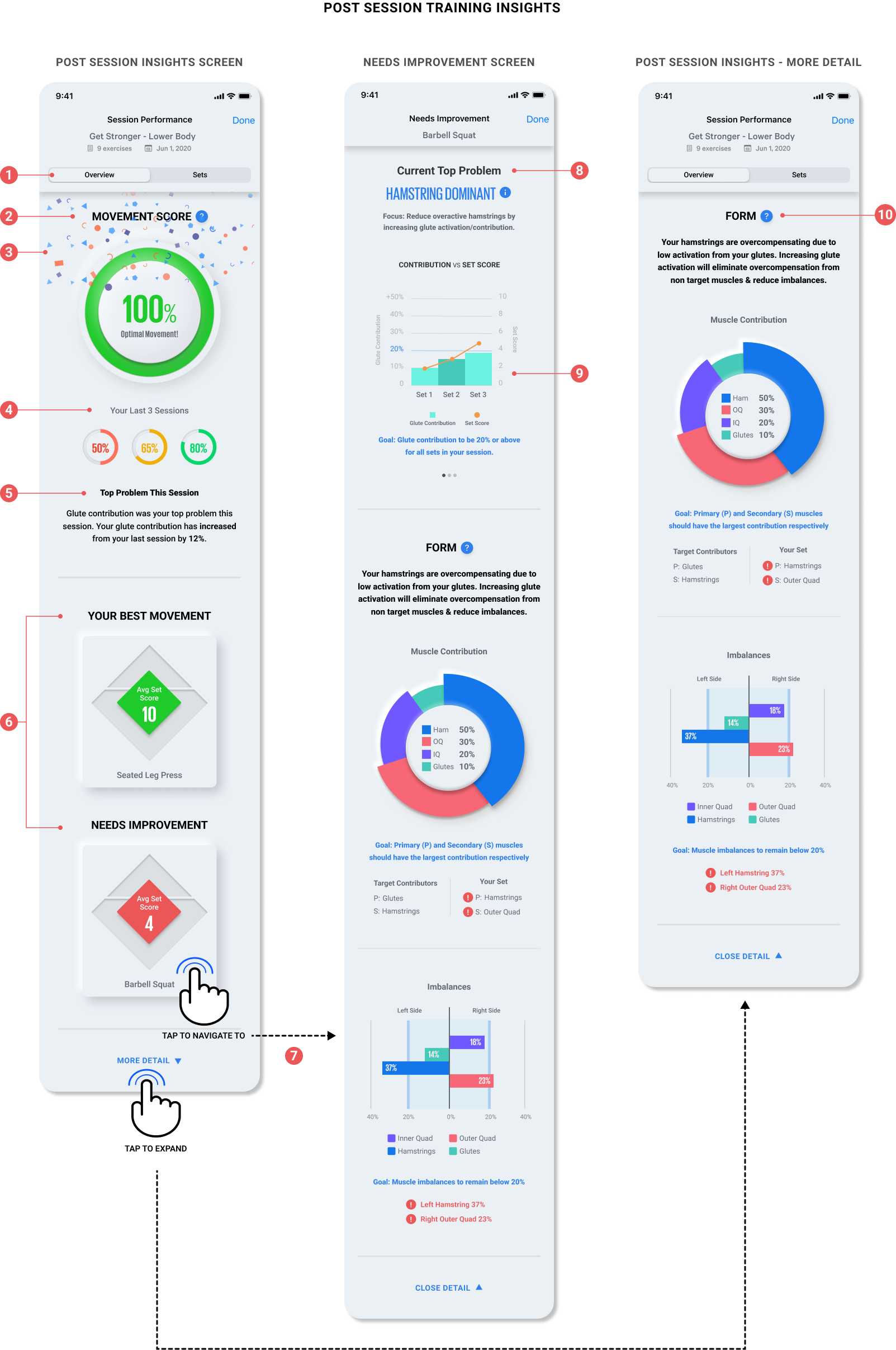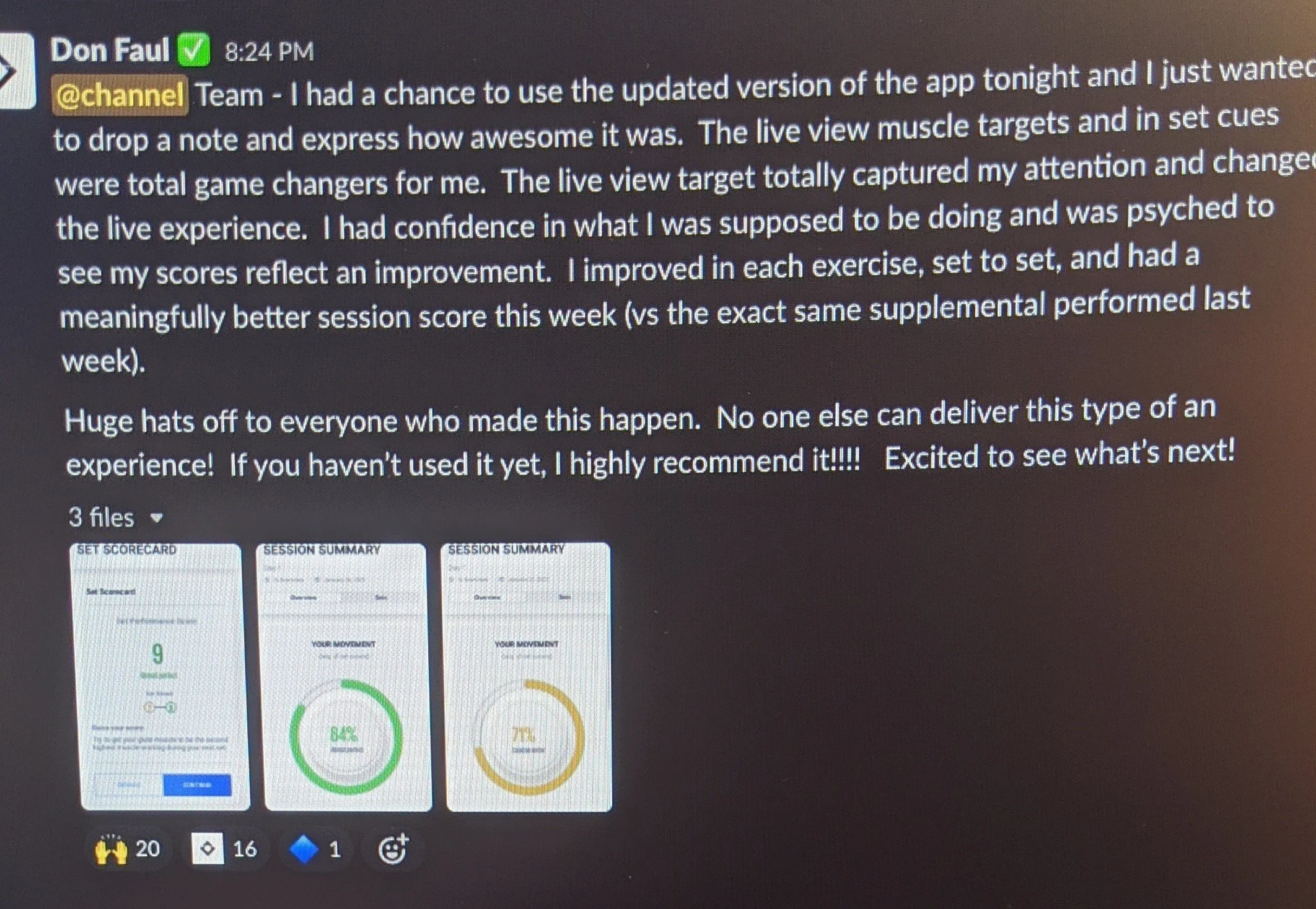
POST TRAINING INSIGHTS
CASE STUDY
Timeline
Feb 2020 - May 2020
What I Did
performed as the sole product designer on the project
user experience research
user journey & empathy mapping
user flows
design sketching & wireframes
persona development
data visualization
competitive analysis
ideation & rapid prototyping
user testing
UI design & design system creation + implementation
worked w/ iOS engineering to implement design
Who I Worked With
Company founder/Business development & Marketing to understand stakeholder needs
Customer service & outreach teams to understand our customer pain points
Applied sport scientists to understand sports science concepts & metrics
Data scientists to understand the captured data
Front end/back end/iOS engineering to build & implement designs

Athos’s Goal
To help users achieve their fitness goals & reduce chances of injury by optimizing their training performance through analyzing muscle activity captured during training sessions for movement deficiencies.
Athos’s efficacy is centered around coaching the user in the moment via in-app post training insights to improve their movement proficiency.
Basically, the better the user executes their movements during training, the more optimal their overall performance becomes & the faster they can achieve their fitness goal without sidelining injuries.
After completing a set/exercise (post set) or a full training session (post session) users are shown data & insights about their performance.
Multiple training sessions are aggregated & evaluated for movement deficiencies & possible red flags that could lead to suboptimal training or injury.

High cognitive load from the in-app training insights reduced Athos’s efficacy in optimizing User performance & preventing injury.
Users were having trouble comprehending the post training feedback because the app didn’t educate the user about the training metrics shown or how they’re related to improving performance towards the user’s fitness goal. This meant users couldn’t extract value from the insights which reduced engagement & user retention.
Pain Points uncovered during user testing for the App Redesign Case Study helped to empathize with why users struggled with Athos training insights.
PAIN POINTS causing the high cognitive load in post training insights
Click image to enlarge
Users don’t understand what factors determine the Set Score or what is a good/bad score (Ex: is the range from 0-10 or 0-100%).
The users wins (good performance ) aren’t celebrated/differentiated reducing motivation & engagement.
Users don't understand what the metrics shown mean or what values are good/bad/expected.
When data values aren’t shown (empty state) the user isn’t informed as to why.
Non CTA’s and CTA’s look too similar.
Users must deep dive too many levels to extract insight.
Users aren’t educated on how any of the metrics/framework shown relate to their overall goal, or how they can raise their scores & improve.
Key insights
Athos post training insights used applied sport science concepts that were too technical & unfamiliar for users’ to comprehend.
Fitness goals take time to achieve & users can get overwhelmed & demotivated along the way.
Data without context causes confusion. Users aren’t coaches/trainers & they want an easy to understand story that ties in with their fitness goal, not just stats. Athos needs to be the coach.
At the top level, users prioritize knowing what they’re doing wrong & want guidance on how to fix their deficiencies w/o having to think.
Scoring movements creates a gamification aspect that subconsciously drives desire in the user to raise their score.
Some users like to dive deeper into data, while some users care less about the detailed data & just want to know how to improve.
Athos’s value doesn’t come from having generic workout programs (e.g. Volt, NTC, etc.) it comes from the personalized insights & corrective strategies we provide our users' with to address their movement deficiencies.

Post training insights just threw stats at the user with no context & that weren’t tied to the user’s fitness goals because the user needs weren’t defined.
User empathy was established by discovering the pain points in the current post training feedback that were causing high cognitive load. Doing so exposed that Athos wasn’t really offering insights, but rather just showing stats that weren’t tied-in to the story of progression towards the user’s specific fitness goal. This happened because Athos had neglected to define the user needs for post training insights.
Actionable user need statements help to better define the problems that need to be solved.
A user need statement is an actionable problem statement used to summarize who the user is, the user's need, and why the need is important to that user. They condense the perspective on the problem & clarify what to solve before moving on to generating potential solutions. User need statements capture what a design is trying to achieve, not how.
User need statements have 3 components
A user + a need + a goal
[A user] needs a way [to do something] in order to [accomplish a goal].
Parent User Need Statement
As a non athlete user with a specific fitness goal, I want to be able to easily understand my workout performance without excessive cognitive load/stress so that I can progress towards my fitness goals without injuries and remain motivated to keep training.
Child User Need Statements
Post Set Use Case
As a non athlete user with a specific fitness goal, I have limited time & energy between sets during a workout & want to be able to quickly understand what factors affected my set performance so that I can improve my performance for the next set.
Post Session Use Case
As a non athlete user with a specific fitness goal, I have more time to deep dive into data after a training session & would like the ability to view the data + factors used to evaluate my performance so that I can trust that Athos knows my body & is providing accurate insights.
Long Term Goal Use Case
As a non athlete user with a long term fitness goal, I want a simple way to see how my overall workout performance is progressing over time so I can easily understand how I’m trending towards my fitness goal.
Non Pro Use Case
As a non athlete user with a specific fitness goal, I want to know what I’m doing well & more importantly what I need to improve on & how to improve it, so that I’m not wasting my time + effort during workouts & stay motivated.

Ideation began with examining how to create a habit forming loop to drive user motivation & engagement.
Nir Eyal’s book Hooked: How to Build Habit-Forming Products offers great insight into the psychology of how to create a habit forming loop within a product to foster user engagement. It proposes that habit-forming products are developed using a four-step process that “when embedded into products, subtly encourages desired customer behavior.” The loop involves a trigger (internal/external) which drives an action that results in a reward which in turn drives user investment/engagement in the product.
Why does the habit loop matter?
Getting people to train regularly isn’t easy. The cognitive load involved with knowing what to do, how to do it & if you're doing it correctly combined with the physical stress of training can easily demotivate a person.
Whiteboarding Athos’s Habit Loop
Click image to enlarge
The ‘Internal Trigger’ for our users is thEIR desire to achieve a specific fitness goal, but they’re not sure of…
What must be done or how to do it.
If what they’re doing is correct or working.
If what they’re doing is wrong, how do they fix it?
Doing must be easier than thinking in order to initiate the ‘Action’ phase.
The personalized Athos training programs + corrective supplemental plans + post training insights all combine to offer a personalized coaching experience alleviating the friction & cognitive load of figuring out what to do creating an external trigger enabling the user to focus on just getting the workouts done aka the ‘Action’ phase.
Users feel rewarded & are motivated to keep training when they understand what they’re doing & are getting results.
The habit loop shows us that Athos post training feedback & insights are the ‘Reward’ for the user because they take the cognitive load out of understanding how well the user is executing their workouts & if they’re progressing towards achieving their fitness goal.
By keeping the user informed on what to do, how well they’re doing it, and that their efforts are producing results, they’ll be motivated to keep training with Athos.
The habit loop exposed that post training insights are where Athos can condition user behavior & foster engagement.
Users will keep training with Athos if they trust that Athos understands their body & can help make it easier & safer to achieve their fitness goal.

How Might We (HMW) statements were used to reframe the insights from empathizing with the user into opportunity areas that are used to help ideate innovative solutions.
HMW… facilitate engagement throughout the long term journey of achieving a fitness goal so that the user remains motivated to keep training with Athos. (Engagement)
HMW… educate users about their set/session performance in a simple, concise, and easy to understand manner. (Data w/ Context)
HMW… provide personalized in the moment coaching based on Athos data to help relieve the cognitive load involved with knowing how to fix the users movement deficiencies. (Reduce Cognitive Load + Personalized Coaching)
HMW… present post training data at various levels of granularity to cater to both data driven & non data driven users. (Macro vs Micro)
HMW… inform users about their training performance in a manner that motivates users to improve their performance. (Motivation)
After defining the core user needs for in-app post training insights & the role that the insights play in the user journey; the HMW statements were used to generate rough concepts in a rapid ideation exercise known as Crazy 8’s where the goal is to sketch eight distinct ideas in eight minutes.
The current post training feedback used applied sport science concepts that were too technical & unfamiliar for users’ to comprehend.
The new post training insights needed to be centered around concepts the user could understand easier & that told a story related to their goal.
An idea that came out of the Crazy 8’s ideation exercise was to simplify the post training insights by having more universally familiar concepts that users can easily understand like Strength & Fitness.
The Strength & Fitness categories have key movements (e.g., squats for strength) that are performed weekly/bi-weekly to evaluate the user's progression towards their goal. Movements in both pillars would be evaluated on the 3 attributes…
Form: Does your body recruit the proper motor units to perform the movement safely & effectively using the proper range of motion.
Balance: Does your body distribute the load evenly when performing the movement.
Intensity: How does the load affect your form, balance, and strength output
KISS
Keep It Simple Stupid
A coaching section (Coach Says) informs users on what they’re doing correctly (On Track) & what needs improvement (Needs Help). The coaching would offer…
Observations: Macro level observations based on the weekly summary data.
Insights: Key insights into what that data captured is showing & why.
Recommendations: A training recommendation based on the insights.

Vetting before investing…
It was important to validate how effective, if at all, the simplified post training framework was to the user before committing resources to further develop the system.
A rough clickable prototype was quickly made for user testing done both internally & also with the previous user testing participants.
We Wanted to Learn…
What information do users want to see post set vs post session?
What information do users want to see after many sessions?
Do users understand our prototype & can they explain back the story of what’s being shown in the prototype?
Overall, do users better understand their training progression?
Do they understand key takeaways from the Strength & Fitness framework?
Do users value the information we provide & does it differentiate Athos from competitors, why/why not?
Key Findings
Users successfully understood their movement proficiency & training progression from the simplified Strength & Fitness assessment pillar system.
Users want & value coaching insights that are data driven & that break down their training performance towards their goal progression because it removes a layer of cognitive complexity.
“I would buy this because I need more insights on what I’m doing, imbalances, and how I’m progressing; and the Athos data gives me those insights.”
— user test subject

collaborating with the experts to further develop a simplified post training insights framework.
After validating that users responded well to a simplified story that focused on relating their training movement proficiency to their fitness goal, I collaborated with the Athos in-house Applied Sport Scientists to formulate an accurate sports science based system that could work across all training scenarios.
Athos didn’t need to reinvent the wheel.
The new story for post training insights centered around improving the users movement proficiency.
Athos already had a system to categorize movement deficiencies (e.g. overactive hamstrings, underactive glutes, etc.) known as musculoskeletal injury (MSI) buckets. This existing system was leveraged & modified to create ‘Top Problem Buckets,’ (aka MSI buckets) for simplicity.
Users would be placed in Top Problem buckets according to their movement deficiencies observed during training.
Example:
1. A user’s goal is to increase their lower body strength (squat 225lbs).
2. The user is prescribed an Athos training program & consistently has low glute contribution over a week of training sessions, so the user is placed in the ‘Underactive Glutes’ MSI bucket.
3. The user is assigned corrective supplemental training plans to perform next week in addition to their normal training program that focuses on increasing their glute contribution.
4. Users Top Problem is fixed which improves their movement proficiency increasing their lower body strength (user goal) & prevents injury from recruiting the wrong muscles.
Click image to enlarge
top problem buckets serve as milestones & drive incremental motivation by giving the user a short term goal to focus on that works toward achieving their long term fitness goal.
The new post training feedback framework
Keeping in line with KISS, the concepts of Strength & Fitness were further simplified to the single metric of ‘Form’ to evaluate movement proficiency. Form is a well known concept that most users are already familiar with & is comprised of Muscle Contribution & Imbalance.
Ironing out the logic and creating an implementable automated system.
In collaboration with the applied sports science team the logic on how to score movement quality mapped out. The new framework was mapped out in Jira/Confluence & shared with engineering to develop an automated system.
The new post training insights would have four main elements:
- Performance Grade: An overalll score rating the user’s set or session performance.
- Performance Trending: A section showing how the user is trending at a glance.
- Reduce Cognitive Load: A real-time coaching cue telling the user how to improve alleviating cognitive complexity for the user & providing in the moment coaching.
- Data Granularity & Data w/ Context: An expandable section of detailed training data that explains the user’s performance alleviating cognitive complexity for the user.
Jira/Confluence Scoring + Insights logic page
Click image to enlarge

THE SOLUTION
A Closer Look At The Improvements
Post set the main user need is to inform the user about their performance & how they can improve for the next set.
During a workout the user should be focused on performing their sets & post training feedback shouldn’t take the user out of their workout flow. The user shouldn’t be distracted or overwhelmed with unnecessary complex data, thus post set insights were designed to be layered & concise to not disrupt the workout & are geared towards improving performance at the micro level (set by set).
Post Set User Need
As an athlete/user with a specific fitness goal, I have limited time & energy between sets during a workout & want to be able to quickly understand what factors affected my set performance so that I can improve my performance for the next set.
Post Set Goals
Inform the user about their set performance
Coach on how to improve for the next set
Convey what factors influenced the user’s Set Score
“I don’t care about the detailed data right now, just tell me how well I performed my set & how I can improve for the next set.”
Macro Layer: The non-data driven user
Evaluate Performance: Set Score rates set performance (scale of 1-10) based on the simple concept of Form (muscle contribution & imbalance metrics.) Users can view the logic behind how the set score is calculated via the ‘?’ CTA.
Contextualize Performance: Set Score range is color coded & also provides visual + verbal qualifiers to inform users where their score falls at a glance.
Trending At A Glance: Users can see their performance for the last 3x’s they performed the exercise informing them on if they’re trending upwards/downwards at a glance.
Coach On How To Improve: ‘How To Your Raise Score’ provides a personalized dynamic cue based on the set data which concisely informs the user on how they can improve their performance for the next set removing cognitive load.
“I want to see exactly what factors influenced my Set Score so I can trust that Athos understands my body & knows how to improve my performance.”
Micro Layer: The data driven user
Data Layers: ‘More Detail’ CTA allows for the data driven user to dive deeper & see more specific data/metrics.
Keep It Simple, Stupid (KISS): Users can see that ‘Form’ is a combination of Muscle Contribution & Imbalance which are easy to understand metrics that impact their Set Score.
Coach & Reduce Cognitive Load: Users are given insight into what their top form problem was for the set.
Relate Performance To Goals: Users can easily see the goals expected for Muscle Contribution & Imbalance which in turn determines their set score & effects progress towards their fitness goal.
Post session insights focus on the same metrics for consistency but at the macro level (aggregate of all sets) to evaluate movement proficiency.
Post Session the workout is complete so users have more time to dive deeper into data. Post session training insights are geared towards corrective coaching at the macro level (sum of sets), while post set insights offer corrective coaching at the micro level (set by set).
Post Session User Need
As an athlete/user with a specific fitness goal, I have more time to deep dive into data post session and would like the ability to view the data + factors used to evaluate my performance so that I can trust that Athos knows my body and is providing accurate insights.
Post Session Goals
Evaluate the user’s movement proficiency for the session.
Inform the user on what their ‘Top Problem’ was for the session.
Inform the user about their best and worst movements for the session.
The same framework centered around Muscle Contribution & Imbalance is used to keep consistency across all post training insights. This helps to tell a coherent story where only the level of granularity is what changes, minimizing confusion & cognitive load.
Users can see an overview of their session performance (macro level) & view individual set performance (micro level).
‘Movement Score’ (aka Movement Proficiency) informs users about their session performance. Tapping the ‘?’ CTA reveals how the Movement Score is calculated (avg of all sets).
High Movement Score’s are visually animated & celebrated in a gamification manner triggering a Dopamine response which helps to drive intrinsic motivation to achieve high Movement Scores.
Users can see their performance for the last 3 sessions informing them on how they’re trending at a glance & if their performance is improving or declining.
‘Top Problem This Session’ concisely informs the user on what their biggest problem was during the session based on the session data & alleviates cognitive load.
Users are shown their best & worst movements. Only one of each is shown in order to not overwhelm the user & to keep the user focused on fixing one problem at a time.
Users can tap on the movement card to see more detail about the movement.
Users can see their top problem (aka MSI bucket) for the week & the corresponding goal focus.
Users can cycle through various simplified graphs that summarize the users movement progression during the session.
Muscle Contribution & Imbalance for all sets in the session are averaged & by using the same metric framework shown post set, it keeps the story of movement proficiency coherent across both moments.
WEEKLY top problem coaching
At the end of a week the sessions performed & their Movement Scores are aggregated & evaluated to find the users biggest movement deficiency referred to as the users ‘Top Problem.’ The Top Problem gives users a milestone/short term goal that works towards their long term fitness goal while also providing incremental motivation.
Top problem Goals
Inform the user on what their ‘Top Problem’ was for the week & why.
Reduce cognitive load by educating the user about the casue & effect of their Top Problem.
Reduce cognitive load/provide personalized coaching & establish trust that Athos knows the users body by offering a corrective strategy to rectify the user’s Top Problem.
Users are prescribed corrective supplemental coaching to rectify their ‘Top Problem.’ This reduces the cognitive complexity involved with fitness training & establishes trust that Athos understands the user’s body.
Users receive a New Weekly Recommendation alert when they’ve been placed into a new ‘Top Problem’ bucket.
The new Top Problem bucket is clearly displayed.
Users are provided with the main flagged metric that resulted in them being placed into their specific Top Problem bucket, explaining the why.
The goal for the metric is clearly displayed.
Users are prescribed a corrective supplemental plan & can click the supplemental CTA to view details about the supplemental plan.
Users are given the ‘Cause’ behind their movement deficiency removing cognitive load.
Users can see the focus of the assigned supplemental plan and the performance goal target.
Users can see an explanation for the target muscle of the supplemental plan.
Users are provided with an explanation on activation for the supplemental plan target muscle.
Users can view the exercises involved with the supplemental plan.
Training trends & insights over time are key to tying the story of long term goal progression together & needed their own section.
‘My Performance’ gave users a place to see their training history, weekly corrective supplemental plans, and their training progress over time at various levels of granularity which allowed for a bird's eye perspective that was extremely helpful for spotting training trends & patterns that offered valuable insights.
Long Term Goal User needs
As a non athlete user with a long term fitness goal, I want a simple way to see how my overall workout performance is progressing over time so I can easily understand how I’m trending towards my fitness goal.
‘My Performance’ gave users a place to see their training history, weekly corrective supplemental plans, and their training progress over time at various levels of granularity which allowed for a bird's eye perspective that was extremely helpful for spotting training trends & patterns that offered valuable insights.
Users can revisit their session history & see the amount of muscular activity (Training Load graph) for all sessions performed.
Users can revisit their performed sessions & access data like exercises performed & post set/session evaluation data.
Users have a place to track their weekly supplemental plan progress providing them with short term milestones that work toward their long term goal.
Users are informed of their current Top Problem bucket & the corrective goal.
Assigned supplemental compliance is tracked.
Users are informed of their current supplemental goal progress at a glance.
‘This Week At A Glance’ uses a flash card carousel to inform users about their weekly progress at glance & allows users to choose what metrics they want to track. Cards can be expanded for more detail.
Users can view key metrics + progress (e.g. Top Problem buckets, imbalances, strength) plotted over time at different levels of granularity which is helpful to spot trends & patterns at a macro level.
Useful high level insights based on the time frame selected are provided on a scrolling carousel & can be expanded for deeper detail.
Users can view their best & worst performance for key metrics that work toward their goal progress.
HOW DO WE MEASURE SUCCESS
The new post training insights successfully simplified complex training metrics into easy to understand concepts that users could comprehend & which were effective in improving user performance & preventing injury.
Athos had a goal to reduce the injury rate for 500 users in six months & 1,500 users in a year.
Injury rate declined for 612 users within three months of the new post training insights framework being implemented.
~78% of users improved their session scores within the two months of release.
User feedback surveys reported the new My Performance section was a key feature in helping users to comprehend their overall training performance & goal progression.


